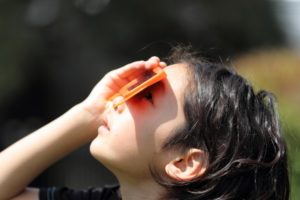There’s a ton of buzz about the upcoming total solar eclipse on August 21, 2017 and for good reason: It will be the first total solar eclipse to travel across the North American sky in nearly 100 years, and one of only a few in the next 100 that will even be visible from the United States.
Because it’s so rare, many people are planning to watch it. But it’s also a more dangerous event than many people realize. Watching an eclipse without protecting your eyes can cause irreversible damage to your vision.
What happens during a solar eclipse
A solar eclipse happens when the moon passes between Earth and the sun, blocking the sun’s rays and casting a shadow on the Earth. In a partial eclipse, the moon blocks only part of the sun. But in a total solar eclipse, the entire sun is blocked at the peak of the eclipse, making it appear dark outside, even in midday. This moment of total darkness is the only time it’s safe to look at the eclipse, not in the minutes before or after.
Much of the country will only see a partial eclipse on Aug. 21; the path where the eclipse will be total is a diagonal line that begins in Oregon and ends in South Carolina. Here’s a map of the total eclipse path.
It’s tempting to look up during either eclipse, but to understand why you shouldn’t, you need to know a little about your eyes.

How your eye reacts to a solar eclipse
Light enters your eye through the cornea, the thin, translucent membrane that covers the eye. The cornea is dome-shaped, and it bends the light through the pupil and back toward the retina. It is the retina that takes this light and translates it into the images the brain sees, using millions of nerve cells called rods and cones.
If the retina is exposed to intense light and ultraviolet radiation – like that which comes directly from the sun – the rods and cones can be damaged. The final result? The exposure could cause:
- Loss of central vision, distorted vision or altered-colored vision
- Red eyes and/or a gritty sensation
- Extreme light sensitivity and excessive tearing
The damage may not be immediately apparent, but a person could wake up the next day and realize they have a problem. Sometimes the damage heals, taking months or a year. Many times, it’s permanent.
How to safely view the eclipse

So how can you experience one of the major astronomical events of our lifetime without hurting your eyes? Watch it through the safety of one of the following:
Eclipse-viewing glasses. Also known as solar filters and solar viewers, these items resemble the size and shape of 3-D glasses. They’re inexpensive – around $15-$25 for packs of five to 10. Unfortunately, there are some fakes on the market that will not protect your eyes. The American Astronomical Society offers a list of reputable manufacturers of eclipse-viewing devices and retailers that sell them.
Welder’s glasses No. 14. You can pick these up at a welding supply store. Make sure to buy these glasses only from reputable vendors/manufacturers.
A pinhole projection device. You can easily make one of these by putting a pinhole in a piece of cardboard and holding it above another piece of cardboard on the sidewalk to project the image. (Don’t make the mistake of looking at the sun through the pinhole, however. The pinhole is only for projection onto the second piece of cardboard.) NASA’s Jet Propulsion Laboratory features a DIY guide on how to make a pinhole camera.
Is your local library hosting an eclipse-viewing event?
STAR Net – the STAR Library Education Network – is a nonprofit that supports science and technology programming in libraries. The organization has distributed more than two million eclipse-viewing glasses to libraries across the nation for use in eclipse events. Check the STAR Net website to see if your local library is participating.
These things will NOT protect your eyes during a solar eclipse
- Regular sunglasses (even if they screen out UVA and UVB rays)
- Regular 3-D glasses
- Looking at the eclipse through the viewfinder of a camera (the viewfinder is not filtered glass)
- Inexpensive telescopes (they don’t have the proper filters)
Binoculars are only safe if you use special filters to go over the front openings. And if you try to use your smartphone camera during the eclipse, you are at risk of accidentally looking directly at the sun while framing the image.
Take care of your eyes
Eye safety is paramount during the eclipse, but taking care of your eyes is important every day. If you have problems with your eyes or need information on any aspect of your vision, the professionals at Barnet Dulaney Perkins Eye Center want to help.

